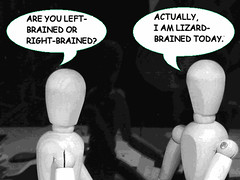Saturday, August 06, 2005
Brains
Cro Magnons
In 1940, four teenagers walking through the woods above the Lascaux manor in southwestern France came upon a hole that had opened up following the fall of a big pine tree. They slivered down into the cave, walked a ways, and discovered walls covered with paintings of big red cows, yellow horses, and black stags. Animal portraits covered grotto walls twenty meters in length, the most impressive trove of Paleolithic art ever discovered. Cro Magnons painted the caves 15,000-20,000 years ago. (As my wife and I discovered when we spent the night there, Cro Magnon is the name of a town in the region, not some mysterious scientific term.)
After World War II, the entrance to the caves was enlarged and the floor lowered, permitting up to 1,200 people a day to visit. I walked through the caverns in 1959, four years before they were closed to halt damage from the breath of hoards of tourists. (You can look at the cave paintings at the Cave of Lascaux site on the web.)
Cro Magnons lived 40,000 - 10,000 years ago, but if you met a Cro Magnon on the street today, cleaned up a bit and stuffed into a suit, you wouldn't be able to tell him from the average banker or accountant. Give a Cro Magnon an MRI, and her brain would look just like yours. Human brains have not evolved since before the caves of Lascaux were painted. You have the same mental hardware as cave people, and this goes a long way toward explaining human behavior when we're put in unnatural, confined, electrified, processed, filtered office environments.
Gray Matter
Your brain weighs about 3 pounds. Your braincase holds about 3 cups of brain, 3 brimming shot-glasses of blood, and another 3 shots of cerebrospinal fluid. A brain is about 5 1/2" wide x 6 1/2" long x 3 1/2" high. It has 100 billion neurons that make 1 quadrillion connections, making the brain one of the most complex contraptions in the universe.
 Pop psychologists have written books galore on the "left hemisphere" and the "right hemispere," but that distinction is trivial compared to the differences among the three brains in your head. Three brains? Why three? Blame evolution.
Pop psychologists have written books galore on the "left hemisphere" and the "right hemispere," but that distinction is trivial compared to the differences among the three brains in your head. Three brains? Why three? Blame evolution.
Nature doesn't swap out an old model brain and replace it with a new one. Organisms evolve one feature at a time. The new stuff is added on top of the old. So you've got a truly ancient brain, which is surrounded by a more recent model, which is partly covered by the latest model. All three are in your head, working away, but sometimes working at cross-purposes.
The Lizard Brain
 Our oldest brain is a lump on top of the spinal column. Call it the lizard brain, for this is all the thinking power a reptile has. The lizard brain controls breathing, heartbeat, digestion, reproduction, and a lot of things we consider automatic. The lizard brain doesn't think; it just does things. It also controls the fight-or-flight response. The lizard brain's concern is survival. If it feels threatened, it can override the other brains. Lizards don't reason or think about the future. They have no emotions. If a reptile comes upon its young after birth, it may eat them.
Our oldest brain is a lump on top of the spinal column. Call it the lizard brain, for this is all the thinking power a reptile has. The lizard brain controls breathing, heartbeat, digestion, reproduction, and a lot of things we consider automatic. The lizard brain doesn't think; it just does things. It also controls the fight-or-flight response. The lizard brain's concern is survival. If it feels threatened, it can override the other brains. Lizards don't reason or think about the future. They have no emotions. If a reptile comes upon its young after birth, it may eat them.
The Dog Brain
 The lizard brain is surrounded by the mammalian brain, which I'll call the dog brain. The dog brain is the seat of emotion. It's why a mama dog nurtures her pups. It's the reason Smokey licks my face in the morning. When I put on my shoes, Smokey and Latte twist and whine with excitement because they think I might be taking them on a walk. They sometimes come when I call them, something my pet snake never did.
The lizard brain is surrounded by the mammalian brain, which I'll call the dog brain. The dog brain is the seat of emotion. It's why a mama dog nurtures her pups. It's the reason Smokey licks my face in the morning. When I put on my shoes, Smokey and Latte twist and whine with excitement because they think I might be taking them on a walk. They sometimes come when I call them, something my pet snake never did.
In humans, the emotional brain is in charge of one small piece of language: swearing. I recall one time in my teenage years that I was chauffering my mother and younger brother in our new Mercedes on the Autobahn. I slowed down for a construction road. An Austrian in a shiny BMW pulled up a few meters behind me and began flashing his headlights to go faster, even though we were already way over the limit. My emotional brain took over. "F**k you, Austrian," I blurted out. My human brain would have handled things differently.
The dog brain can take charge from the human brain. When emotion kicks in, you might say "I'm losing control." Actually, it's just the emotional brain grabbing the steering wheel for a spell.
 The Human Brain
The Human Brain
The latest upgrade is the human brain which gives us reason, logic, language, art... the things that separate us from other mammals.
The human brain is so pleased with itself that it thinks its running the whole show. In the old vaudeville joke, the fellow believes his brain is in charge until he asks himself, "Who's telling me that?" The human brain simplifies our perception of reality and makes things look orderly. Even as we're tugged by forces greater than ourselves, the human brain is telling you, "We're in control of the situation. We can handle this."
Psychologist Robert Ornstein compares the voice in our heads to a little man inside who is continually rewriting our resume. Like a resume, the stories we tell ourselves put a positive spin on the things. Unpleasantries fade away. Mistakes never happened. Like words on a page, the voice carries some authority.
Learning, one brain at a time
A good learning landscape designer addresses the needs of each brain. The subject matter may focus on one brain more than others.
For example, paticipants in Courageous Conversations learn to recognize and point out instances where the lizard brain is pushing for dominance or submission, to the detriment of common assumptions and mutually beneficial outcomes.
Emotional Intelligence is all dog-brained stuff. Because emotion can highjack the human brain at any time, it's of paramount importance in "soft" situations involving empathy, persuasion, humor, passion, joy, and sorrrow. While you're not aware of it, your dog brain processes incoming messages and routes them to the human brain -- or not. Falling in love is not a rational process.
To get through to the human brain, the learning landscape must be safe and inviting. If it's not, consciousness may downshift to the dog brain ("I'm mad as hell and I'm not going to take it any more.") or the lizard brain ("I'm outta here.")
trickster...
Since the early 70s,
Left Brain
Right Brain
Logical
Sequential
Rational
Analytical
Objective
Looks at parts Random
Intuitive
Holistic
Synthesizing
Subjective
Looks at wholes
Most individuals have a distinct preference for one of these styles of thinking. Some, however, are more whole-brained and equally adept at both modes. In general, schools tend to favor left-brain modes of thinking, while downplaying the right-brain ones. Left-brain scholastic subjects focus on logical thinking, analysis, and accuracy. Right-brained subjects, on the other hand, focus on aesthetics, feeling, and creativity.
Linear Vs. Holistic Processing
Logical Vs. Intuitive
Sequential Vs. Random Processing
Verbal Vs. Nonverbal Processing
Symbolic Vs. Concrete Processing
Reality-Based Vs. Fantasy-Oriented Processing
Now age of abundance.
test to find out which hemisphere predominates in your frontal lobes.
Here's another.
Another on-line test comes up with a slight variation. Measuring this stuff is not a precise science.
Your percentage score for the right brain is 33%.
Your percentage score for the left brain is 27%.
And one more....
In 1940, four teenagers walking through the woods above the Lascaux manor in southwestern France came upon a hole that had opened up following the fall of a big pine tree. They slivered down into the cave, walked a ways, and discovered walls covered with paintings of big red cows, yellow horses, and black stags. Animal portraits covered grotto walls twenty meters in length, the most impressive trove of Paleolithic art ever discovered. Cro Magnons painted the caves 15,000-20,000 years ago. (As my wife and I discovered when we spent the night there, Cro Magnon is the name of a town in the region, not some mysterious scientific term.)
After World War II, the entrance to the caves was enlarged and the floor lowered, permitting up to 1,200 people a day to visit. I walked through the caverns in 1959, four years before they were closed to halt damage from the breath of hoards of tourists. (You can look at the cave paintings at the Cave of Lascaux site on the web.)
Cro Magnons lived 40,000 - 10,000 years ago, but if you met a Cro Magnon on the street today, cleaned up a bit and stuffed into a suit, you wouldn't be able to tell him from the average banker or accountant. Give a Cro Magnon an MRI, and her brain would look just like yours. Human brains have not evolved since before the caves of Lascaux were painted. You have the same mental hardware as cave people, and this goes a long way toward explaining human behavior when we're put in unnatural, confined, electrified, processed, filtered office environments.
Gray Matter
Your brain weighs about 3 pounds. Your braincase holds about 3 cups of brain, 3 brimming shot-glasses of blood, and another 3 shots of cerebrospinal fluid. A brain is about 5 1/2" wide x 6 1/2" long x 3 1/2" high. It has 100 billion neurons that make 1 quadrillion connections, making the brain one of the most complex contraptions in the universe.
 Pop psychologists have written books galore on the "left hemisphere" and the "right hemispere," but that distinction is trivial compared to the differences among the three brains in your head. Three brains? Why three? Blame evolution.
Pop psychologists have written books galore on the "left hemisphere" and the "right hemispere," but that distinction is trivial compared to the differences among the three brains in your head. Three brains? Why three? Blame evolution.Nature doesn't swap out an old model brain and replace it with a new one. Organisms evolve one feature at a time. The new stuff is added on top of the old. So you've got a truly ancient brain, which is surrounded by a more recent model, which is partly covered by the latest model. All three are in your head, working away, but sometimes working at cross-purposes.
The Lizard Brain
 Our oldest brain is a lump on top of the spinal column. Call it the lizard brain, for this is all the thinking power a reptile has. The lizard brain controls breathing, heartbeat, digestion, reproduction, and a lot of things we consider automatic. The lizard brain doesn't think; it just does things. It also controls the fight-or-flight response. The lizard brain's concern is survival. If it feels threatened, it can override the other brains. Lizards don't reason or think about the future. They have no emotions. If a reptile comes upon its young after birth, it may eat them.
Our oldest brain is a lump on top of the spinal column. Call it the lizard brain, for this is all the thinking power a reptile has. The lizard brain controls breathing, heartbeat, digestion, reproduction, and a lot of things we consider automatic. The lizard brain doesn't think; it just does things. It also controls the fight-or-flight response. The lizard brain's concern is survival. If it feels threatened, it can override the other brains. Lizards don't reason or think about the future. They have no emotions. If a reptile comes upon its young after birth, it may eat them.The Dog Brain
 The lizard brain is surrounded by the mammalian brain, which I'll call the dog brain. The dog brain is the seat of emotion. It's why a mama dog nurtures her pups. It's the reason Smokey licks my face in the morning. When I put on my shoes, Smokey and Latte twist and whine with excitement because they think I might be taking them on a walk. They sometimes come when I call them, something my pet snake never did.
The lizard brain is surrounded by the mammalian brain, which I'll call the dog brain. The dog brain is the seat of emotion. It's why a mama dog nurtures her pups. It's the reason Smokey licks my face in the morning. When I put on my shoes, Smokey and Latte twist and whine with excitement because they think I might be taking them on a walk. They sometimes come when I call them, something my pet snake never did.In humans, the emotional brain is in charge of one small piece of language: swearing. I recall one time in my teenage years that I was chauffering my mother and younger brother in our new Mercedes on the Autobahn. I slowed down for a construction road. An Austrian in a shiny BMW pulled up a few meters behind me and began flashing his headlights to go faster, even though we were already way over the limit. My emotional brain took over. "F**k you, Austrian," I blurted out. My human brain would have handled things differently.
The dog brain can take charge from the human brain. When emotion kicks in, you might say "I'm losing control." Actually, it's just the emotional brain grabbing the steering wheel for a spell.
 The Human Brain
The Human BrainThe latest upgrade is the human brain which gives us reason, logic, language, art... the things that separate us from other mammals.
The human brain is so pleased with itself that it thinks its running the whole show. In the old vaudeville joke, the fellow believes his brain is in charge until he asks himself, "Who's telling me that?" The human brain simplifies our perception of reality and makes things look orderly. Even as we're tugged by forces greater than ourselves, the human brain is telling you, "We're in control of the situation. We can handle this."
Psychologist Robert Ornstein compares the voice in our heads to a little man inside who is continually rewriting our resume. Like a resume, the stories we tell ourselves put a positive spin on the things. Unpleasantries fade away. Mistakes never happened. Like words on a page, the voice carries some authority.
Learning, one brain at a time
A good learning landscape designer addresses the needs of each brain. The subject matter may focus on one brain more than others.
For example, paticipants in Courageous Conversations learn to recognize and point out instances where the lizard brain is pushing for dominance or submission, to the detriment of common assumptions and mutually beneficial outcomes.
Emotional Intelligence is all dog-brained stuff. Because emotion can highjack the human brain at any time, it's of paramount importance in "soft" situations involving empathy, persuasion, humor, passion, joy, and sorrrow. While you're not aware of it, your dog brain processes incoming messages and routes them to the human brain -- or not. Falling in love is not a rational process.
To get through to the human brain, the learning landscape must be safe and inviting. If it's not, consciousness may downshift to the dog brain ("I'm mad as hell and I'm not going to take it any more.") or the lizard brain ("I'm outta here.")
trickster...
Since the early 70s,
Left Brain
Right Brain
Logical
Sequential
Rational
Analytical
Objective
Looks at parts Random
Intuitive
Holistic
Synthesizing
Subjective
Looks at wholes
Most individuals have a distinct preference for one of these styles of thinking. Some, however, are more whole-brained and equally adept at both modes. In general, schools tend to favor left-brain modes of thinking, while downplaying the right-brain ones. Left-brain scholastic subjects focus on logical thinking, analysis, and accuracy. Right-brained subjects, on the other hand, focus on aesthetics, feeling, and creativity.
Linear Vs. Holistic Processing
Logical Vs. Intuitive
Sequential Vs. Random Processing
Verbal Vs. Nonverbal Processing
Symbolic Vs. Concrete Processing
Reality-Based Vs. Fantasy-Oriented Processing
Now age of abundance.
Pink in WIred: The Information Age has unleashed a prosperity that in turn places a premium on less rational sensibilities - beauty, spirituality, emotion. For companies and entrepreneurs, it's no longer enough to create a product, a service, or an experience that's reasonably priced and adequately functional. In an age of abundance, consumers demand something more. Check out your bathroom. If you're like a few million Americans, you've got a Michael Graves toilet brush or a Karim Rashid trash can that you bought at Target. Try explaining a designer garbage pail to the left side of your brain! Or consider illumination. Electric lighting was rare a century ago, but now it's commonplace. Yet in the US, candles are a $2 billion a year business - for reasons that stretch beyond the logical need for luminosity to a prosperous country's more inchoate desire for pleasure and transcendence.The Throwing Madonna
Logical, linear, analytic thinking remains indispensable. But it's no longer enough.
Developing these high concept, high touch abilities won't be easy for everyone. For some, the prospect seems unattainable. Fear not (or at least fear less). The sorts of abilities that now matter most are fundamentally human attributes. After all, back on the savannah, our caveperson ancestors weren't plugging numbers into spreadsheets or debugging code. But they were telling stories, demonstrating empathy, and designing innovations. These abilities have always been part of what it means to be human. It's just that after a few generations in the Information Age, many of our high concept, high touch muscles have atrophied. The challenge is to work them back into shape.
10
Left Brain, Right Brain:
Science or the New Phrenology?
William Calvin
Left, right, left, right--the marching song of the two-mind movement. To hear them talk, you'd think that everyone had a second mind, suppressed by the first. That the vocal left brain dominated the poor artistic right brain. Preventing it from getting a creative thought in edgewise. Soon there will be a consciousness raising movement: Stop referring to the left cerebral hemisphere as the "dominant" one. Invent a more egalitarian term like co-chairperson. Co-chairhemisphere?
Although a few percent of people have right brains that are language-dominant, about 93 percent of us use the left side. A few percent have "mixed dominance," where both sides are used for language (that is, injecting anesthetics on either side will interfere with speech).
test to find out which hemisphere predominates in your frontal lobes.
Jay, you are Balanced-brained
That means you are able to draw on the strengths of both the right and left hemispheres of your brain, depending upon a given situation.
When you need to explain a complicated process to someone, or plan a detailed vacation, the left hemisphere of your brain, which is responsible for your ability to solve problems logically, might kick in. But if you were critiquing an art opening or coming up with an original way to file papers, the right side of your brain, which is responsible for noticing subtle details in things, might take over.
While many people have clearly dominant left- or right-brained tendencies, you are able to draw on skills from both hemispheres of your brain. This rare combination makes you a very creative and flexible thinker.
The down side to being balanced-brained is that you may sometimes feel paralyzed by indecision when the two hemispheres of your brain are competing to solve a problem in their own unique ways.
Here's another.
You responded as a right brained person to 10 questions, and you responded as a left brained person to 8questions. According to the Hemispheric Dominance test, you use your right brain the most. The summary briefly describes your dominance type.
Another on-line test comes up with a slight variation. Measuring this stuff is not a precise science.
You Are 30% Left Brained, 70% Right Brained
Your percentage score for the right brain is 33%.
Your percentage score for the left brain is 27%.
And one more....
You are more right-brained than left-brained. The right side of your brain controls the left side of your body. In addition to being known as right-brained, you are also known as a creative thinker who uses feeling and intuition to gather information. You retain this information through the use of images and patterns. You are able to visualize the "whole" picture first, and then work backwards to put the pieces together to create the "whole" picture. Your thought process can appear quite illogical and meandering. The problem-solving techniques that you use involve free association, which is often very innovative and creative. The routes taken to arrive at your conclusions are completely opposite to what a left-brained person would be accustomed. You probably find it easy to express yourself using art, dance, or music. Some occupations usually held by a right-brained person are forest ranger, athlete, beautician, actor/actress, craftsman, and artist.
